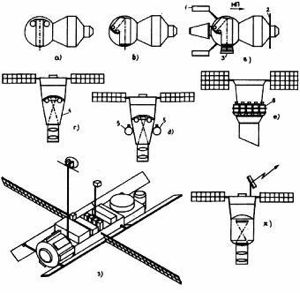
Home - Search - Browse - Alphabetic Index: 0- 1- 2- 3- 4- 5- 6- 7- 8- 9
A- B- C- D- E- F- G- H- I- J- K- L- M- N- O- P- Q- R- S- T- U- V- W- X- Y- Z
Yantar-4K2
AKA: 11F695;Kobalt;Yantar-4. Status: Cancelled 1991. First Launch: 1981-08-21. Last Launch: 2002-02-25. Number: 82 . Gross mass: 6,600 kg (14,500 lb).
Improved military photo-reconnaissance satellite. Although using the basic Yantar-4K1 bus, the Yantar-4K2 would be launched by the Zenit-2 launch vehicle, allowing the number of precision-landing film return capsules to be increased to 22, and the duration in orbit to be increased to 120 to 180 days.
Flight trials of the Yantar-2K indicated the satellite was not capable of providing strategic warning of attack. A meeting of the Council of Chief Designers at TsSKB in May 1977 reviewed alternative approaches. Three additional variants were to be developed, one of them the high resolution Yantar-4K. The project was to be implemented in two phases: the Yantar-4K1, launched by the existing Soyuz-U launch vehicle, and the Yantar-4K2, to be launched by the new more powerful Zenit launch vehicle.
TsSKB's revised panoramic camera system was developed for detailed broad spectrum reconnaissance and survey. Development was begun in April 1979. The draft project was completed at the end of 1980. Before the Yantar-4K2 could fly, the Soviet Union experienced financial problems, then dissolved completely. The booster for which it was designed was now built in a foreign country (the Ukraine), and the project was abandoned.
More at: Yantar-4K2.
Family: Military surveillance sat, Surveillance, Surveillance orbit. Country: Russia. Agency: Kozlov bureau. Bibliography: 102, 110, 4, 451, 6, 7049, 13366.
1977 May - .
- Council of Chief Designers reconsiders Yantar Soviet reconnsat designs - .
Nation: Russia.
Spacecraft: Orlets-1,
Orlets-2,
Yantar-2K,
Yantar-4K1,
Yantar-4K2,
Yantar-4KS1,
Yantar-6K,
Yantar-6KS.
Flight trials of the Yantar-2K indicated the satellite was not capable of providing strategic warning of attack. The planned Yantar-6K series, in development since 1969, were overweight and behind schedule. A meeting of the Council of Chief Designers at TsSKB reviewed alternative approaches. It was decided that three variants of the Yantar-2K were to be developed, one of them the high resolution Yantar-4K.
Back to top of page
Home - Search - Browse - Alphabetic Index: 0- 1- 2- 3- 4- 5- 6- 7- 8- 9
A- B- C- D- E- F- G- H- I- J- K- L- M- N- O- P- Q- R- S- T- U- V- W- X- Y- Z
© 1997-2019 Mark Wade - Contact
© / Conditions for Use
